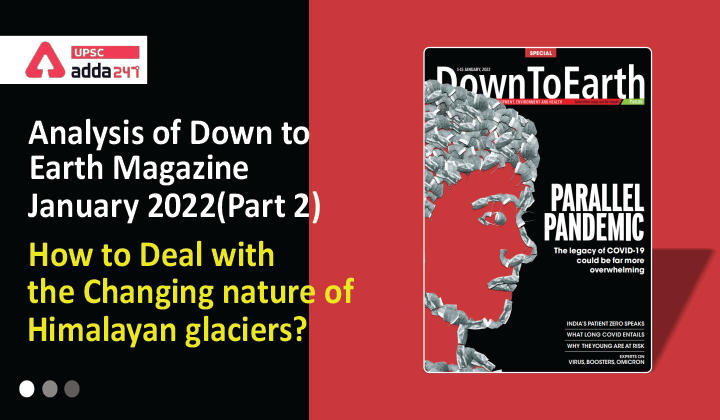Table of Contents
Context
Many studies reveal that the renowned Himalayan glaciers have lost over 40% of their area, threatening millions of people in Asia with a lack of water availability.
Key Points
- The Himalayan Mountain range is the world’s third-largest amount of glacier ice, after Antarctica and the Arctic, but the rapidly shrinking Himalayan glaciers have been shown to be melting far faster than glaciers in other parts of the world.
- Meltwater released by Himalayan glaciers forms the headwaters of the major river systems in Asia, supporting food and energy production downstream, as well as maintaining a range of ecosystems and ecosystem services.
- Ongoing recession and thinning of Himalayan glaciers raise concerns about the sustainability of water supply in the region.
- Recent rates of ice loss across the region exhibit marked spatial and temporal variability and there is consensus that recession has accelerated over recent decades.
What are the unique characteristics of the Himalayan glaciers?
- Nepal has summer accumulation-type glaciers because the country receives more than 80 per cent of its precipitation during the summer.
- Another characteristic of the glaciers is that the ice is covered with layers of debris such as soil, sand, rocks, pebbles and even big boulders.
- If the thickness of the debris is more than 1 m then the melting rate of the ice is slow. If the debris is thin, 2-3 cm, then the rate of melting becomes high.
- The debris absorbs more solar radiation as they are black or brown in colour. The energy budget on the glacier surface would be different with a little debris on the ice.
Has the snowfall pattern in the Himalayas changed recently?
- We have the satellite data which only shows the snow cover area, not the depth. As per the satellite data, the snow cover area is decreasing on a decadal scale.
- In terms of rainfall, no noticeable trend is visible.
- But variations are visible in terms of temperature rise.
- For example, Nepal’s maximum temperature increased by a significant 0.0560 C per year between 1971 and 2014.
- The minimum temperature also increased, but the rate is lower at 0.0020 C per year. The rising temperature makes the Nepal Himalayas more vulnerable.
Factors that impact Himalayan glaciers?
- In the context of increasing temperatures, another important aspect is the settling of black carbon on the glaciers which increases the rate of melting.
- The impact of black carbon deposition on the melting of ice from the Nepalese glaciers is relatively less but we have some data that it is impacting Tibetan and Indian glaciers.
- What we can also say is that not just the black carbon on the surface of the glaciers but atmospheric black carbon also increases air temperatures at higher altitudes.
- The increase in water vapour in the higher altitudes is leading to warming, as water vapour is a greenhouse gas.
- It is also found that during winters, the increasing water vapour in the Nainital and Ladakh regions of India was increasing temperatures. A similar thing may be happening in the Nepalese glaciers, as well.
How Climate Change is Responsible?
- The glacial decline is closely related to climate change. There are 5 million springs in the Himalayas and they are showing a decline because of overuse by an increasing population, but also because of retreating glaciers and depleting groundwater levels.
- This is alarming because the populations that live in the upper and middle Himalayas, in villages and even towns, are immediate dependent on spring water. NITI Aayog has also set up a committee to look at springs in the Himalayas. But there needs to be a mission mode policy on this
- In many parts of HKH springs are drying up due to prolonged pre-monsoon drought as a result of climate change, threatening the way of life for local communities and downstream areas.
- Climate warming is affecting hydrological regimes in the HKH region because of factors like changes in seasonal extremes, increased evapotranspiration, and changes in glacier volume.
Way Forward
- Countries in South Asia must work together to manage hydropower resources, an important source for the region’s clean energy needs and a generator of energy trade and security.
- Regional cooperation will be necessary to create joint adaptation strategies. A first step could be sharing information about the evolving state of glaciers and the risks associated with it.
- Water resource management policies must evolve because the trends we are observing point to a different and more challenging future.
- We can slow glacier melt by collectively acting to curb the black carbon deposits that are speeding the thinning of the ice.



 TSPSC Group 1 Question Paper 2024, Downl...
TSPSC Group 1 Question Paper 2024, Downl...
 TSPSC Group 1 Answer key 2024 Out, Downl...
TSPSC Group 1 Answer key 2024 Out, Downl...
 UPSC Prelims 2024 Question Paper, Downlo...
UPSC Prelims 2024 Question Paper, Downlo...
